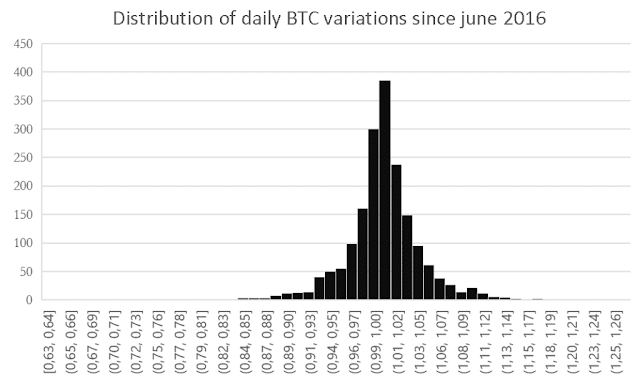In recent years, the sustained development of the cryptocurrency market has contributed to the emergence of a substantial supply of cryptocurrencies of all kinds. The crypto currency market is very concentrated on a few cryptos, and very dependent on the global economy. Even if some crypto currencies are structurally outperforming or underperforming, it seems essential to us, in addition to studying the asset concerned, to study the overall context given the global dependence of active cryptos on the economy. Back to 5 things you must know before investing in cryptocurrency
1. CASH AND CRYPTOCURRENCIES
Cryptocurrencies are assets to be studied with two main dimensions: a singular dimension, specific to each cryptocurrency, and a global dimension, of market analysis. The main trends today stem from global financial mechanisms.
One of the main aspects of the market is the study of liquidity and players.
The chart above shows the correlation between the S & P500 and the US central bank's balance sheet. The recurrence of increasingly accommodating monetary policies greatly increases the sensitivity of the markets to available liquidity. Thus, we observe that since the 2008 crisis, liquidity has remained generally abundant.
However, the implementation of more restrictive monetary policies, consisting of reducing the central bank's balance sheet and raising rates, were put in place from 2017. This led to strong tensions on liquidity, stagnation relative equity, and an implicit overvaluation of more speculative assets such as cryptocurrencies. This is part of the explanation for the fall in cryptocurrencies between 2018 and 2019. The COVID crisis has led to policies of strong money creation and the implicit undervaluation of stock market indices.
Clearly, crypto assets are speculative assets, which depend very heavily on the overall liquidity in the portfolio. Monetary conditions are therefore a central explanatory factor in the resulting asset price readjustment processes. It is therefore important to first study the state of the market. The markets alternate successively between short-term and long-term liquidity shortages, more or less intense.
Furthermore, not all cryptocurrencies have the same sensitivity to rising demand due to the abundance of liquidity. At the start of 2020, 0.01% of crypto asset market agents held 32% of Bitcoin's supply. The proportion of institutional investors in a market is more or less able to reflect the level of available liquidity and thus price volatility.
2. VOLATILITY AND CRYPTOCURRENCIES
Another element of analysis of the overall state of the crypto currency market is volatility. Volatility corresponds to the amplitude of price variation, that is to say more concretely the perceived stress in the markets. Volatility is an important financial indicator to study, as it allows the psychological and fundamental phases of the market to be measured.
Cryptocurrencies are assets that are extremely sensitive to an increase in volatility in equities, for example. Indeed, volatility depends in part on available liquidity, which explains the fact that the rise in crypto assets is often herald of more volatile periods in equities.
Statistically, almost all of the major bullish phases in cryptocurrency occurred during a period of overall declining volatility. Put another way, cryptocurrencies are rebounding from major highs in medium-term volatility (see chart above).
Volatility is therefore one of the implicit determinants of the price of cryptocurrencies and of the overall state of the market. Volatility is measured using indicators like the VIX for S & P500 stocks. As the equity market is much larger than that of crypto currencies, this is an indicator to put into perspective with the sensitivity of cryptocurrencies. Volatility is also different from one cryptocurrency to another. For example, Ethereum is generally more volatile than Bitcoin, which increases risk over certain time periods.
3. STUDY THE STATISTICS OF DAILY VARIATIONS IN BITCOIN OVER THE LONG TERM
This graph represents the distribution of the daily variations of Bitcoin between 2016 and 2020. The average daily variation since 2016 of Bitcoin is + 0.3%, which is equivalent in theory to an average annual performance of + 198%. In addition, more than 2/3 of the daily variations take effect between -3.88% and + 4.5%. One third of the variations are therefore of a more extreme nature. Statistically, we deduce that it is therefore more interesting to position oneself over time than over short periods. In addition, it should be noted that the volatility and performance is different according to each cryptocurrency. In management theory, higher volatility (higher proportion of extreme variations) should result in a lower share of the portfolio in the asset considered.
Another aspect of market statistics is the manifestation of more or less favorable periods for buying. The above graph shows the absolute variations of Bitcoin between 2016 and 2021. We observe on the one hand the alternation between phases of strong and weak variations, and on the other hand the alternation between strong upward variations followed by strong downward variations (2017, 2019, 2021). The study of the intensity of variations in the asset under consideration is therefore an indication of future risk. For example, strong bullish movements in Ethereum are generally a little later than those in Bitcoin.
Finally, the study of seasonality can partly join this approach. Statistically, Bitcoin benefits the most from April, May, October, and November. Conversely, it is more impacted by the months of January, July, August, and particularly September.
4. THE CYCLICITY OF CRYPTOCURRENCIES
The study of the cyclicality of crypto currencies thus constitutes a continuation of the statistical study. Some technical analysts have advanced the recurrence of certain periodicities on cryptocurrency. By observation, we will in fact note the recurrence of certain periods such as 8.6 months (260 to 265 days). Thus, the bullish cycle between the low point of March 2020 and the high of mid-April 2021 was exactly 1.5 cycles of 8.6 months, or 397 days. In short, there are times that are cyclically less conducive to investing.
In addition, globally, the cryptocurrency market remains linked to economic and financial cycles. The chart above shows the comparison between the VIX (blue), the central bank's key rate (black), and the spread between the 10-year and 2-year rate (red). At the top of the economic cycle, the risk is low (the spread between the 10-year and 2-year rate is minimal), and the volatility is very low. Then, the manifestation of a crisis leads to a fall in key rates, and mechanically to an increase in volatility. As seen previously, this later leads to an economic recovery and in some cases an abundance of liquidity, and ultimately, a rise in cryptoassets.
The cyclicality of crypto currencies therefore depends on statistical developments specific to the market on the one hand; but also overall statistical developments (economy, equity market, bonds, etc.) on the other hand.
5. STUDY THE SPECIFIC CHARACTERISTICS OF EACH CRYPTO
By mid-2021, nearly 75% of the cryptocurrency capitalization was concentrated on the 5 largest cryptocurrencies. The virtual currency market is very fragmented. Almost all cryptocurrencies have low visibility and are very competitive. The study of the associated project behind each cryptocurrency is therefore of central importance.
Several parameters are to be studied: capitalization (market share), volatility, average performance, similar projects, actors behind the cryptocurrency, project objectives, etc. Beyond Bitcoin, there are indeed many cryptos that outperform more or less over time. Capitalization and its evolution is the first determining parameter. Thus, a small share of the capitalization of the given cryptocurrency in the total capitalization of the market, generally reflects the presence of greater risks. Studying the average performance, volatility, or share of the crypto currency in question in the market, allows you to adjust the share of the portfolio dedicated to the asset in question.
In addition, the potential for success of a cryptocurrency often depends on its visibility (like Bitcoin or Dogecoin) or on its usefulness (Ethereum or Ripple). Competition between cryptocurrencies has increased sharply in recent months, with the emergence of a large number of projects. It is therefore important to distinguish the innovation potential and the visibility potential of each project. The whole of this study should be put in perspective with the overall state of the market, which explains most of the major market trends.
Ultimately, investing in a crypto currency involves a comprehensive study of the market and a study specific to each cryptocurrency. Liquidity and volatility are two main determinants of the overall condition of the market in the medium and long term. Then, the study of statistics specific to the market and the cryptocurrency in question reveals the appearance of certain periods more or less favorable for investment. Studying statistics is also useful in determining one's investment strategies. In addition, cyclicality plays an important role in the opportunities and risks observed in the market. Finally, studying the project and the potential for visibility or utility makes it possible to differentiate its investments.







